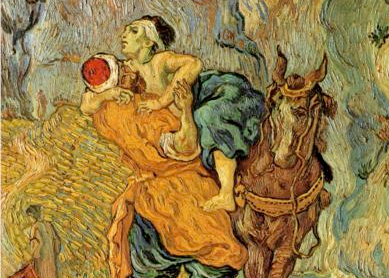Jesus’ teaching and storytelling abilities are on display in the dialogue about the Good Samaritan. Throughout the conversation Jesus employs a Socratic technique by mirroring the lawyer: he responds to the lawyer’s two questions not with answers but with questions of his own (Luke 10:26, Luke 10:36). Jesus only gives answers in response to answers the lawyer gives (Luke 10:28, Luke 10:37). Jesus thereby invites the lawyer to participate actively in exploring the answers to his own questions. As is typical of Jesus’ parables, this one disorients and subverts conventional views.
How does a person inherit eternal life?
In directing the lawyer to the law (“What is written in the law?”), and affirming his response (“You have given the right answer”), Jesus indicates that the key to inheriting eternal life is to be found not in him but in obeying the Torah commandments to love God and neighbor (Deut 6:5, Lev 19:18). Ironically, Christians who locate eternal life in Jesus depart from Jesus’ own emphasis here. Torah obedience is one of several Jewish traditions elevated in Luke: it is the only Gospel that mentions Jesus’ circumcision and that concludes with Jesus’ followers worshiping God in the Jewish temple (Luke 2:21, Luke 24:53).
As in Luke 18:18-30, Jesus makes clear that eternal life is tied not only to Torah obedience but also to using one’s possessions to benefit strangers in desperate need. Most of the actual parable itemizes numerous specific ways the Samaritan aids the injured man: he uses his own oil and wine to bandage his wounds, places him on his own animal, takes him to an inn, takes care of him, pays the innkeeper two denarii, and remarkably, promises to repay the innkeeper whatever more costs are incurred in caring for the injured man. Loving one’s neighbor in this story is risky and economically costly.
Jesus argues that inheriting eternal life is entirely dependent on loving God and neighbor (Deut 6:5, Lev 19:18). There is no indication that faith, belief, ritual acts (for example, circumcision, temple worship, baptism, Eucharist), or one’s religious or ethnic status (as a Jew or Christian) plays any role in inheriting eternal life. Ethical action is all that matters, a point Jesus emphasizes in the only two answers he offers the lawyer: “Do this and you will live…Go and do likewise.”
Jesus changes the focus of the word “neighbor” away from a recipient of love (as in Lev 19:18, “love your neighbor,” and the lawyer’s own question in Luke 10:36) to the person who does the loving (“Which of these three was a neighbor to the man who fell into the hands of the robbers?”). There is a shift in this text from an object orientation, to love (“Whom shall I love?”) to a subject orientation, in which one develops a capacity for loving that is not dependent upon the identity of the one loved.
What is significant about a Samaritan?
Samaritans were ethnic and religious outcasts to many first-century Jews. Descended from intermarriage between Israelites and foreigners, Samaritans were part Jewish; they were “Mudbloods” (to use J. K. Rowling’s phrase). Religious differences were significant. Samaritans only regarded the five books of the Torah as “Scripture”; they had their own version of these texts (the Samaritan Pentateuch), and—in violation of Deut 12; they worshipped God in their own temple at Mount Gerizim rather than at the temple in Jerusalem. Samaritans were to Jews what Muslim extremists are to many Christians in America: an ethnic and religious enemy. Jews and Samaritans visited violence upon each other, and in 128 B.C.E. some Jews destroyed the Samaritan temple. To call the Samaritan in the story “good” (a word never used in the text) is to participate in a racist assumption that being “good” is an unusual and noteworthy achievement for Samaritans.
The use of the Samaritan subverts two conventional perceptions among ancient Jews. The first is the belief that eternal life is the exclusive privilege of one’s own religious (or ethnic) community. But in this story the one who inherits eternal life (because of his love for the needy man) is the religious-ethnic outsider and enemy. (Potentially disturbing as well is the tacit claim that the priest and Levite would not inherit eternal life due to their failure to love the man in need.) The story threatens a second ancient Jewish perception: referring to the Samaritan, Jesus concludes the dialogue by saying, “Go and do likewise” (Luke 10:37). Jesus presents the Samaritan not as someone to pity—or even love—but as a person to imitate. The ethnic and religious enemy is not only the story’s hero; he is the moral exemplar.
Bibliography
- King, Martin Luther Jr. “The One-Sided Approach to the Good Samaritan.” Pages 239-40 in Advocate of the Social Gospel. Vol. 6 of The Papers of Martin Luther King Jr. Edited by Susan Carson, Susan Englander, Troy Jackson, and Gerald L. Smith. Berkeley: University of California Press, 2007.
- Fromm, Erich. The Art of Loving. San Francisco: Harper, 2006.
- Scott, Bernard Brandon. Hear Then the Parable: A Commentary on the Parables of Jesus. Minneapolis: Augsburg Fortress, 1989.
- Crossan, John Dominic. The Power of Parable: How Fiction by Jesus Became Fiction About Jesus. SanFrancisco: HarperCollins, 2012.
- Snodgrass, Klyne. Stories with Intent: A Comprehensive Guide to the Parables of Jesus. Grand Rapids, Mich.: Eerdmans, 2008





